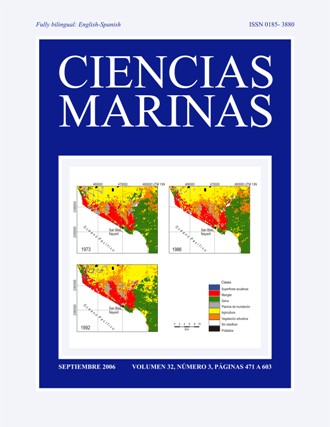Mesoscale variability of the Mexican Tropical Pacific using TOPEX and SeaWiFS data
Main Article Content
Abstract
The Mexican Tropical Pacific has oligotrophic characteristics; however, it sustains an abundant biodiversity, mainly because of upwelling promoted by its relatively shallow thermocline, strong winds and mesoscale eddies. These features, together with thermocline depth and stratification variability, are the main factors regulating phytoplankton abundance. We analyzed the seasonal and interannual variability associated with eddy activity and phytoplankton abundance, both measured indirectly by sea level anomalies (TOPEX/Poseidon) and surface chlorophyll a (SeaWiFS). Data analysis was based on their average fields, canonical correlations and empirical orthogonal functions (EOFs). The first two EOFs of sea level anomaly (SLA) and surface chlorophyll a (CHL) accounted for the variability associated with the formation of cyclonic and anticyclonic eddies near the gulfs of Tehuantepec and Papagayo during winter and spring. Both types of eddies were related to local increases in CHL. The signal of the eddies was observed along 10°N as far as 150°W. The variability associated with cyclonic eddies was more important than that associated with anticyclonic eddies. This behavior is opposite to what is commonly accepted. Along the equator, negative SLAs were coupled with high CHL as a consequence of the shoaling of the thermocline followed by nutrient enrichment of the euphotic zone. Positive SLAs coupled with high CHL off South America are a result of the permanent upwelling promoted by the Peru-Chile Current. The effects of the El Niño-La Niña conditions were detected in five of the seven EOFs analyzed.
Downloads
Article Details
This is an open access article distributed under a Creative Commons Attribution 4.0 License, which allows you to share and adapt the work, as long as you give appropriate credit to the original author(s) and the source, provide a link to the Creative Commons license, and indicate if changes were made. Figures, tables and other elements in the article are included in the article’s CC BY 4.0 license, unless otherwise indicated. The journal title is protected by copyrights and not subject to this license. Full license deed can be viewed here.

